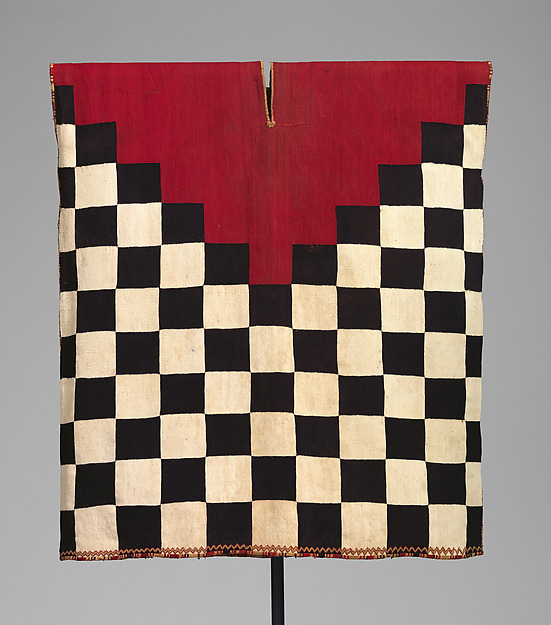Notes: well, it's late, and a late search turned up a couple things I don't want to lose...if I had a whole lot of funds, I'd snag this!

Pre-Columbian Inca clothes poncho for child in fabric
3 500 €
unquote
bit much!...it's for a child, and has the step fret design...well, let me work backward the steps that brought me to it...before that I was looking at a checker board tunic...the checker board was the emblem of the Inca army...all the soldiers wore it...
quote

This fine tapestry-woven garment features identical black-and-white checkerboard designs on front and back, inside and out, with a red, V-shaped yoke and meticulously embroidered finished edges. Worn by men over a loincloth, such garments were one of the primary markers of identity in the Inca Empire. This type of tunic was first mentioned in 1532 by Francisco de Jerez, secretary to the conquistador Francisco Pizarro. Jerez described the fateful meeting between Atahualpa, the Inca emperor, and Pizarro's small band of men in Cajamarca, Peru, noting that the first regiment of the Inca army wore checkerboard livery.
Cloth was of profound importance in Inca culture: no political, military, social, or religious event among the Inca was complete without textiles being exchanged or gifted, burned or sacrificed. Fine tapestry woven tunics would have been bestowed on warriors who distinguished themselves on the battlefield, or given as diplomatic gifts by Inca rulers in their campaigns to expand their vast empire. Ownership and use of tapestry tunics would have been closely controlled by the Inca state, and only those upon whom such gifts were bestowed were allowed to wear them. The Inca also exerted tight control over the production of tapestry tunics, and surviving full-size examples display remarkably little variation in size.
Inca tapestry tunics were woven as a single panel with single-interlocking joins, with the neck slit held closed by a temporary weft yarn that was removed after the weaving was complete. Once the finished weaving was cut from the loom, all seams and selvage edges were completely covered with fine double faced embroidery. The seams were concealed with a precisely repeated series of multicolored bands of different widths. Along the bottom, just above that embroidered edge, a zigzag line was created with similarly colored yarns. The precise meaning of this zigzag line is unknown, but it was of such importance that it was included in depictions of royal tunics in one of the earliest illustrated manuscripts concerning the Inca Empire (Guaman Poma de Ayala 1615-1615).
Cloth was of profound importance in Inca culture: no political, military, social, or religious event among the Inca was complete without textiles being exchanged or gifted, burned or sacrificed. Fine tapestry woven tunics would have been bestowed on warriors who distinguished themselves on the battlefield, or given as diplomatic gifts by Inca rulers in their campaigns to expand their vast empire. Ownership and use of tapestry tunics would have been closely controlled by the Inca state, and only those upon whom such gifts were bestowed were allowed to wear them. The Inca also exerted tight control over the production of tapestry tunics, and surviving full-size examples display remarkably little variation in size.
Inca tapestry tunics were woven as a single panel with single-interlocking joins, with the neck slit held closed by a temporary weft yarn that was removed after the weaving was complete. Once the finished weaving was cut from the loom, all seams and selvage edges were completely covered with fine double faced embroidery. The seams were concealed with a precisely repeated series of multicolored bands of different widths. Along the bottom, just above that embroidered edge, a zigzag line was created with similarly colored yarns. The precise meaning of this zigzag line is unknown, but it was of such importance that it was included in depictions of royal tunics in one of the earliest illustrated manuscripts concerning the Inca Empire (Guaman Poma de Ayala 1615-1615).










No comments:
Post a Comment